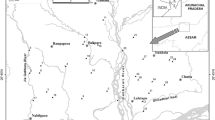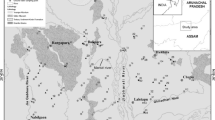Abstract
The aim of this study was to display distribution and relationships of heavy elements in the unconfined, shallow alluvial aquifers of the lower Jia Bharali catchment and adjoining areas in central part of North Brahmaputra Plain (NBP), India using hydrochemical as well as multivariate statistical techniques such as principal component analysis (PCA) and cluster analysis. The original matrix was made up of 10 trace elements (As, Cd, Cu, Co, Cr, Fe, Mn, Pb, Ni and Zn) estimated from 50 shallow alluvial dug wells in both the wet and the dry season for a duration of 3 hydrological years (2008–2011). Except As, Cu and Zn all the other toxic metals in the shallow aquifers were found exceeding the WHO maximum permissible limits for drinking water. PCA extracted five varimax factors as geogenic, agricultural and anthropogenic explaining about 71.2% of the total variance in the wet season and 69.3% total variance in the dry season. Hierarchical cluster analysis classified the dug wells into two groups in the wet season and three groups in the dry season with respect to the heavy elements. The results emphasized the need for routine monitoring and management in order to avoid contamination of groundwater sources in the NBP with respect to the dissolved trace elements.
Similar content being viewed by others
References
Alloway, B.J., Heavy Metals in Soils, London: Blackie Academic and Professional, 1995.
APHA, AWWA (American Public Health Association) Standard methods for the examination of water and wastewater, American Public Health Association, Washington D.C., 1998.
Danielsson, A., Cato, I., Carman, R., and Rahm, L., Spatial clustering of metals in the sediments of the Skagerrak/Kattegat, Applied Geochem., 1999, vol. 14, pp. 689–706.
Das Jyotirmaya, Geochemistry of trace elements in the groundwater of Cuttack City, India, Water, Air, Soil Pollut., 2003, vol. 147, pp. 129–140.
Duarah, B.P. and Phukan, S., Seismic hazard assessment in the Jia Bhareli river catchment in eastern Himalaya from SRTM-derived basin parameters, India Nat Hazards, 2011. doi 10.1007/s11069-011-9761-4
Farnham, I.M., Johannesson, K.H., Singh, A.K., Hodge, V.F., and Stetzenbach, K.J., Factor analytical approaches for evaluating groundwater trace element chemistry data, Anal. Chim. Acta, 2003, vol. 490, pp. 123–138.
Hem, J., Inorganic chemistry of lead in water: in Lead in the Environment, Lovering, T.G., Ed., U.S. Geol. Survey Professional Paper, 1976, vol. 957, pp. 5–11.
Khound Nayan, J., Phukon, P., and Bhattacharyya, K.G., Dissolved trace metals in the shallow aquifers of the Jia-Bharali River Basin, Assam, India, J. Geol. Soci. India, 2013, vol. 82, pp. 162–168.
Lattin, J., Carroll, D., and Green, P., Analyzing multivariate data, N.Y.: Duxbury press, 2003.
Meglen, R.R., Examining large databases: a chemometric approach using Principal Component, Mar. Chem., 1992, vol. 39, pp. 217–237.
Nandy, D.R., Mullick, B.B., Basu Chowdhury, S., and Murthy, M.V.N., Geology of the NEFA Himalayas, The seminar on recent geological studies in the Himalayas, Calcutta, 1971.
Shamsudduha, M., Uddin, A., Saunders, J.A., and Lee, M.K., Quaternary stratigraphy, sediment characteristics and geochemistry of arsenic contaminated alluvial aquifers in the Ganges–Brahmaputra floodplain in central Bangladesh, J. Contam. Hydrol., 2008, vol. 99, pp. 112–136.
Singhal, B.B.S. and Gupta, R.P., Applied Hydrogeology of Fractured Rocks, The Netherlands: Kluwer Acad. Publishers, 1999.
Welch, A.H. and Lico, M.S., Factors controlling As and U in shallow groundwater, southern Carson Desert, Nevada, Appl. Geochem., 1998, vol. 13, pp. 521–539.
WHO, Guidelines for drinking water quality. Vol. 2, Health criteria and other supporting information, Geneva: WHO Publ., 1984.
Author information
Authors and Affiliations
Corresponding author
Additional information
The article is published in the original.
Rights and permissions
About this article
Cite this article
Khound, N.J., Bhattacharyya, K.G. Hydrochemical and Multivariate Statistical Evaluation of Heavy Metals in Shallow Alluvial Aquifers of North Brahmaputra Plain, India. Water Resour 45, 966–974 (2018). https://doi.org/10.1134/S009780781806012X
Received:
Published:
Issue Date:
DOI: https://doi.org/10.1134/S009780781806012X




